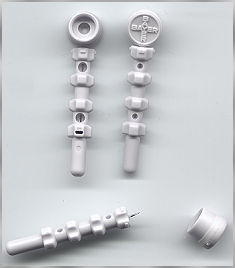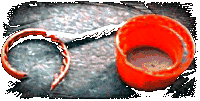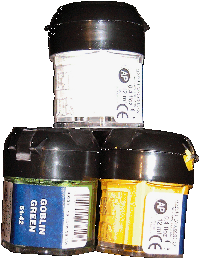
and Materials
(not all of them, mind you....)

|
- |
|
|
- |
|
|
- |
|
|
- |
|
|
- |
|
|
- |
|
|
- |
|
|
- |
|
|
- |
|
|
- |
|
|
- |
|
|
- |
|
|
- |
|
|
- |
|
|
- |
|
|
Of course there are some downsides, |
No silencer needed |
|
Spinning tops.... |
Another highly valuable tool is the The idea behind the dremel concept It is an extremly useful addtion to |
|
Caution: - Never get the tool wet. - Wear protective googles. Working - If you have long hair, always |
"DAS Pronto" is a mediocre material for raw sculpts.
It can always be re-softened with water (= not water-proof !)
and does a good job sticking to the figures. It is, however not
very
good forsculpting fine structures as it will easily break in the
process due to it's fragile nature and great weight.
Efa Plast is another air-curing compound and - in my view-
superior to "DAS". It is great for smooth surfaces, nice for
sculpting and filling fine ridges and bumps and hardens
relatively
quick. Like Das Pronto, it remains water soluble.
Yet, it seems to be less brittle and is a tad lighter.
Oh, and it doesn't stink like Das Pronto does.
This is some great oven-hardening material.
When hardened properly, it assumes a consistence
which is very reminiscent of harder plastic and the surface
remains very smooth. It is easy to sculpt and flawlessly
assumes almost any shape you apply to it,
making it a good choice for negative casts.
Of course the only few figures can withstand the "baking"
procedure, so take that into consideration before you
sculpt directly onto the figure. If you need to, Fimo can
also be hardened instantly with boiling water, but this
"shock-therapy" will make it rather brittle, so distant
details will break easily. Choose wisely !
Also, I would suggest not harden it in the same oven you
use for your lifestock - You can never be careful enough.
However, the most favorable method would be the use of
a heat gun - That would be the most dangerous method,
as well, though.
I could as well put the ever-so-popular
"Play Doh" clay into this spot as it's nearly
identical with this. Kids Dough does, how-
ever have a deciding advantage: It's cheaper.
I use this stuff for the finer works of sculpting.
It is, intentional or not, air-drying and very
user-friendly. The downside of it is that it
fails where "Das Pronto" succeeds: It is very
hard to wrap around and stick to a figure.
Fortunately, It can be applied to a "Das Pronto"
base quite nicely. The rough surface does keep
the Clay attached and the moisture of it re-softenes
the ground enough for the to materials to slightly
blend into one.
When you read my little reports,
you'll likely stumble over the term `AL´.
In case I left you wondering what the
hell that means, I'll tell you just that:
AL's are something I'm lucky to have.
 |
You see, one of my relatives suffers of |
|
Ames Lancetes, or AL's, as I like to |
|
 |
When this medical instrument they're |
|
The bad thing about them is the pricing. In order to
serve their I'd better settle with this box for now. |
 |
Yes, bottle caps. Believe it or not, those |
|
Apart from the fact that you should wear those |
 |

These paints are a classical choice
for plastic models - Preferably those of
the same brand.
On the plus side, Revell Color applies very well
to the surface of almost every figure and is 100%
water-proof.
On the other hand, they're not exactely quick-drying
and don't mix all to well. You will also need some
paint thinner - At least if you want to use your
brushes more than once.
Another problem is that the chemicals in this paint
often react with the plastic of figures, resulting in
a perpetually sticky/shiny surface.
All in all, I have to say that the downsides overweight
the advantages, making this a non-recommended
product.
Remember to use this in well-ventilated areas only !

Albeit virtually unknown, these paints
are very user-friendly.
These are waterbased and come in three variations:
BasicColor (poster paint) Decorlaque and Decormat.
Of course, "Decormat" is the thing to use in most cases,
but since this line doesn't cover every color there is, you
likely won't get around using the other ones, as well.
Marabu colors are water-based. They are water-proof after
drying, though, and you won't need expensive
& toxic paint thinner to thin the colors out, mix them,
or remove them (as long as they're still wet).
They are also very, very easy to mix. Once, I mixed
one color of each line and some ordinary aquarell
paint (!) for good measure and it worked like a charm.
The disadvantage to this brand of paint is that it is
rather thick and thus highly likelable to rub off
joint areas.

Citadel Paint is very comparable to the aformentioned
Marabu Paint, but it's consistency is much thinner - I'd
even say "cremier" - and more liquid without losing any
of it's paint brilliance. It's also internationally available.
Clear Laque

A clear laque finish is the best way of
giving a custom it's final touch - Only
a unified surface can make the illusion
perfect.
For quite some
time, I've been using glossy laque, but I really can't not
recommend that. The shine usually only just reveals a fi-
gure's fault and doesn't fit very well, anyway.
My current laque of choice is another product
coming from the fine Marabu brand (I hope my
paycheque is in time this time around). It's Marabu
Satin Matt Varnish, which, unlike other Marabu
paint, requires paint thinner for proper use.
Remember to use this in well-ventilated areas only !
Clear Laque Spray

What's better than a good finish ? A better finish.
(I know, that was horrible).
Spray is usually the best way to apply to achieve
an even surface, and this spray here does it's
job well. The only downside is that some
figure's joint seem to stick to the torso a
bit after extended periods of rest, but that's
rather minor.
A word of advice:
When finishing figures this way, it can happen that
the paint starts to fold and crack if paints like Revell have
been used. In that case, don't o anything until the laque has
dryed.
You can only make matters worse - And it's likely that the paint
will settle back to it's usual form on it's own while
drying off.
If possible, use a water-based product to avoid such problems.
Remember to use this in well-ventilated areas only !
Spray Primer

Primer is a great help in even application of paint...
But if you're going to prime your figure, do it the spray
way. Bumpy priming by brushes basically defies it's
entire purpose.
It is, however, important to choose a primer that
is compatible with your paint of choice - If that is
not the case, the paint job will turn into undrying
mush or a cracked mess. So before you go, put
primer and then some paint onto a test surface
(plastic clothes pegs work well) to see if things
work out. If possible, use a water-based product.
Remember to use this in well-ventilated areas only !
(To main)